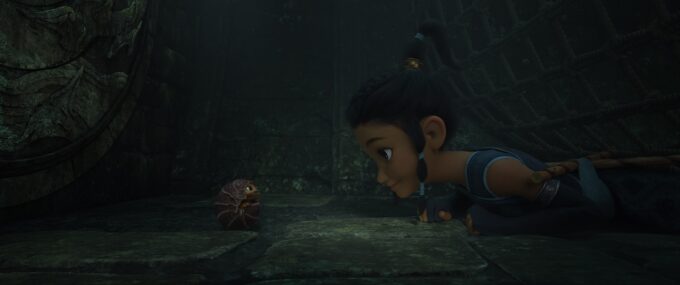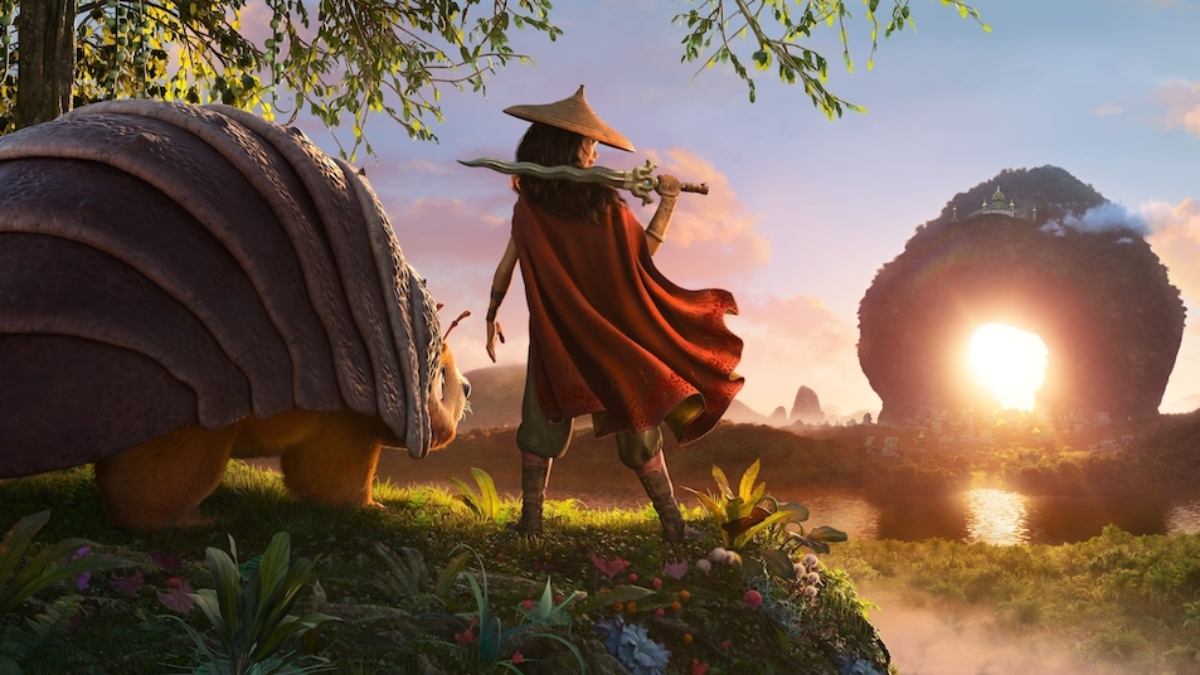Written By: Aditya Sharma
Disney’s “Raya and The Last Dragon” is a vivid and thrilling romp through a world that’s both ancient and thoroughly fresh. In Kumandra, a land of rivers, islands and peninsulas that resembles just enough of each corner of Southeast Asia, we meet our newest warrior-princess: Raya.
As a young girl, Raya (Kelly Marie Tran) always heard from her father, or Ba, Chief Benja (Daniel Dae Kim) of a Kumandra of 500 years ago, when humans lived alongside divine and powerful dragons who protected them and kept peace. However, when the Druun, a dark plague-like energy, began sweeping across the land, turning everyone who touched it to stone, the dragons sacrificed themselves and combined their powers into a single gem. The last dragon, Sisu (Awkwafina), used the gem to stop the chaos but in the process left Kumandra divided into five hostile clans.
Raya’s people are the guardians of that gem when the film begins, but clashing tensions between the clans leave the gem shattered, with each faction holding a piece as the Druun returns. Cut to six years later and Raya is on a quest to find Sisu and recover the pieces, travelling across one of the most visually stunning worlds Disney has ever produced in a story that is just as much “Tomb Raider” as it is “Spirited Away.”
Like all good heroes, Raya has an animal sidekick. She has Tuk Tuk (Alan Tudyk), who in this case is not a motorized three-wheel taxi, but an adorable Pug/Armadillo/Pill-Bug hybrid who curls into a ball that Raya rolls around on to cover ground fast. As an aside, little Tuk Tuk, who we meet in the first fifteen minutes of the film alongside young Raya, easily takes the cake for cutest animal sidekick. Or at the very least, cutest animal sidekick with a repeating two-syllable name (sorry Heihei).

What sticks out from the very start of the film is the care and attention to detail that directors Don Hall and Carlos Lopez Estrada took to make Kumandra come alive with all the vibrancy of Southeast Asia. There are obvious things like the land of Talon, which is a recreation of the many floating markets in countries like Vietnam, Thailand and Indonesia, and gives off the same bustling energy. But it is in the small things that the filmmakers’ thoroughness really shows through, like the deliberate shots of the characters removing their shoes before entering a temple or sacred space. It is the combination of those seemingly small details with the large brush strokes that make the world of “Raya” feel real, and not like a caricature of a diverse and nuanced part of the world.
Similarly, the film has a surprising and welcome amount of grit. The filmmakers pay homage to the various forms of martial arts and fighting styles of Southeast Asia, and that lends itself to some truly epic fight scenes. Most notable among them are the duels between Raya and Namaari (Gemma Chan), Raya’s duplicitous rival from the land Fang. The clashes between these two are vivid and have a deep emotional charge, demonstrating clearly that Raya is the sort of fighter-princess unafraid to make the most of her agency. This puts her squarely among the likes of Mulan, Merida and Moana.
And then, there is Raya’s character. Raya is a young woman, a wanderer and a warrior.
She is scarred by the tragedy of her people and her world, and the film centers around her ruthless ambition and reluctance to trust. Her disposition challenges a lot of the worn tropes of animated heroes (particularly Disney princesses) who often stumble their way into saving their world by magic or friendship or a combination of both.
Raya repeatedly grapples with her inability to open up to the gang of misfits she assembles as she journeys through the five lands, and that character wrinkle is a refreshing reminder that kids don’t need to be hit over the head with protagonists who are moral beacons in a corrupt world. They can empathise with, and indeed learn from leading characters who are just as hesitant to be vulnerable as we all are.
That is in large part because screenwriters Qui Nguyen and Adele Lim imbued the story with a powerful emotional drive to make sure the character’s journey is just as compelling as the world they live in. It would also be impossible without the stellar voice acting on behalf of the entire cast. Kelly Marie Tran is a fierce and driven Raya, Daniel Dae Kim is quickly humble and strong as Chief Benja, and Awkwafina’s performance as the dragon Sisu is a perfect example of her style of comedy that has been wonderfully grounded.
Finally, it is impossible to watch “Raya and The Last Dragon” without feeling the creep-up of real life behind you at all times. If the plague-like Druun and tribal factionalism weren’t enough to make you feel 2021 calling, then the experience of Kumandra will. Violence and hate crimes against Asian Americans are at an all time high, and divisive us-versus-them rhetoric permeates our media. This film then, a story of faith, trust and unity, played out by a cast of characters who are explicitly and unapologetically Asian should be required viewing for all generations.
“Raya and The Last Dragon” is available in theaters and on Disney+.

